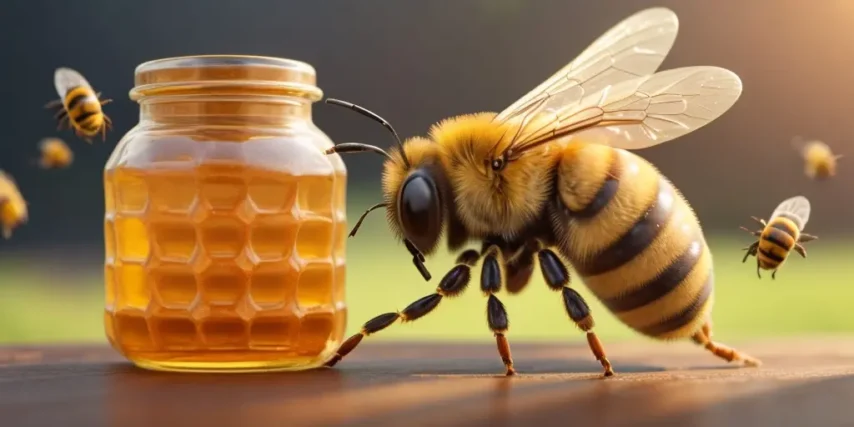The Enchanting Alchemy of Bees: A Dive into the Mysteries of Honey Production
In the intricate tapestry of nature, few phenomena are as mesmerizing as the creation of honey by the humble bee. Honey, often referred to as “liquid gold,” is not just a sweet treat for our taste buds; it is a complex and miraculous substance that serves as a testament to the collaborative efforts of these tiny, buzzing architects. This article will unravel the fascinating process of honey production, shedding light on the intricate steps that transform nectar into the golden elixir we all love.
The Honeybee: A Master Forager
To comprehend the alchemical process of honey production, we must first understand the primary players in this magical symphony – the honeybees. Honeybees, predominantly of the genus Apis, are social insects that work together in highly organized colonies. A typical colony consists of a single queen, thousands of worker bees, and a few drones. While each member of the colony has its role, it is the worker bees that take center stage in the quest for nectar.
The journey begins with foraging worker bees scouring vast expanses of flowers in search of nectar, a sugary liquid secreted by the glands of flowering plants. Nectar serves as the primary raw material for honey production, containing sugars like glucose and fructose along with water, minerals, and various organic compounds.

The Dance of Communication:
Once a forager bee locates a rich source of nectar, it communicates this valuable information to its fellow workers through an intricate dance known as the waggle dance. This symbolic performance conveys details about the distance, direction, and quality of the discovered nectar source. The intensity and duration of the dance provide crucial information to the other worker bees, guiding them to the most abundant and rewarding flower patches.
Harvesting Nectar:
Upon receiving the dance signal, other worker bees embark on the foraging journey, equipped with specialized proboscis – a long, tube-like mouthpart – designed for sipping nectar from flowers. As they land on a flower, the proboscis extracts the sweet liquid, which is then stored in a special organ called the crop. The crop is essentially a temporary storage tank that allows the bee to transport large quantities of nectar back to the hive.
Transformation in the Hive:
Once the foragers return to the hive laden with nectar, the next phase of honey production unfolds within the bustling walls of the colony. Inside the hive, worker bees transfer the collected nectar to house bees by engaging in a process called trophallaxis – a direct exchange of food between individuals. The house bees, in turn, add enzymes to the nectar, initiating the transformation from raw nectar to honey.

Enzymatic Alchemy:
The enzymes added by the house bees play a pivotal role in the conversion of nectar into honey. One key enzyme, invertase, breaks down the complex sugars in the nectar into simpler sugars like glucose and fructose. This enzymatic activity not only alters the chemical composition of the nectar but also increases its viscosity, giving honey its characteristic thickness.
Furthermore, the bees reduce the water content of the nectar through a process of dehydration. This is achieved by fanning the nectar with their wings, creating air currents that facilitate evaporation. As the water content decreases and the sugar concentration rises, the nectar gradually transforms into honey.
Waxing Poetic: Building Honeycombs
As the honey matures, worker bees construct hexagonal wax cells within the hive, commonly known as honeycombs. These geometric marvels serve as both storage units for honey and the nursery for the colony’s brood. The process of building honeycombs is a marvel of precision and collaboration, with each bee contributing to the creation of a seamless structure that maximizes storage space while minimizing the use of resources.
Sealing the Treasure:
Once the honeycombs are filled with mature honey, the bees cap the cells with beeswax to seal the treasure within. This wax capping serves a dual purpose – it preserves the honey by preventing moisture absorption and protects it from contaminants, ensuring the long-term viability of the stored food source.

Harvesting the Liquid Gold:
The final act in the honey production saga involves the beekeeper, who carefully harvests the honey-laden combs from the hive. Modern beekeeping practices prioritize sustainability and ethical treatment of bees, with beekeepers adopting methods that prioritize the well-being of the colonies.
After extracting the honeycombs, beekeepers use centrifugal force or honey extractors to separate the honey from the wax comb. The extracted honey is then filtered to remove impurities, resulting in the pure, golden liquid that graces our tables.
In the enchanting world of honey production, bees emerge as masterful alchemists, transforming humble nectar into a treasure trove of sweetness. The collaborative efforts of worker bees, the intricacies of trophallaxis, and the alchemical wizardry of enzymes all converge to create the golden elixir we know and love. As we savor the honey on our toast or in our tea, let us not forget the intricate dance of nature that brought this liquid gold to our tables – a dance orchestrated by the diligent and industrious honeybee.







